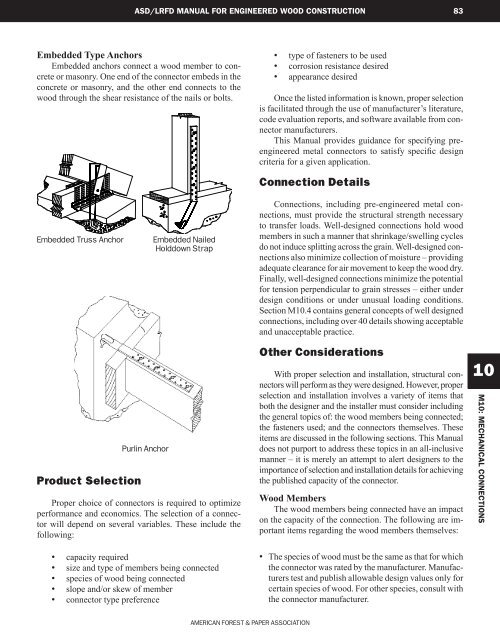ASD/LRFD Manual - American Wood Council
ASD/LRFD Manual - American Wood Council
ASD/LRFD Manual - American Wood Council
You also want an ePaper? Increase the reach of your titles
YUMPU automatically turns print PDFs into web optimized ePapers that Google loves.
<strong>ASD</strong>/<strong>LRFD</strong> MANUAL FOR ENGINEERED <strong>Wood</strong> Construction<br />
83<br />
Embedded Type Anchors<br />
Embedded anchors connect a wood member to concrete<br />
or masonry. One end of the connector embeds in the<br />
concrete or masonry, and the other end connects to the<br />
wood through the shear resistance of the nails or bolts.<br />
• type of fasteners to be used<br />
• corrosion resistance desired<br />
• appearance desired<br />
Once the listed information is known, proper selection<br />
is facilitated through the use of manufacturer’s literature,<br />
code evaluation reports, and software available from connector<br />
manufacturers.<br />
This <strong>Manual</strong> provides guidance for specifying preengineered<br />
metal connectors to satisfy specific design<br />
criteria for a given application.<br />
Embedded Truss Anchor<br />
Embedded Nailed<br />
Holddown Strap<br />
Connection Details<br />
Connections, including pre-engineered metal connections,<br />
must provide the structural strength necessary<br />
to transfer loads. Well-designed connections hold wood<br />
members in such a manner that shrinkage/swelling cycles<br />
do not induce splitting across the grain. Well-designed connections<br />
also minimize collection of moisture – providing<br />
adequate clearance for air movement to keep the wood dry.<br />
Finally, well-designed connections minimize the potential<br />
for tension perpendicular to grain stresses – either under<br />
design conditions or under unusual loading conditions.<br />
Section M10.4 contains general concepts of well designed<br />
connections, including over 40 details showing acceptable<br />
and unacceptable practice.<br />
Product Selection<br />
Purlin Anchor<br />
Proper choice of connectors is required to optimize<br />
performance and economics. The selection of a connector<br />
will depend on several variables. These include the<br />
following:<br />
Other Considerations<br />
With proper selection and installation, structural connectors<br />
will perform as they were designed. However, proper<br />
selection and installation involves a variety of items that<br />
both the designer and the installer must consider including<br />
the general topics of: the wood members being connected;<br />
the fasteners used; and the connectors themselves. These<br />
items are discussed in the following sections. This <strong>Manual</strong><br />
does not purport to address these topics in an all-inclusive<br />
manner – it is merely an attempt to alert designers to the<br />
importance of selection and installation details for achieving<br />
the published capacity of the connector.<br />
<strong>Wood</strong> Members<br />
The wood members being connected have an impact<br />
on the capacity of the connection. The following are important<br />
items regarding the wood members themselves:<br />
10<br />
M10: MECHANICAL CONNECTIONS<br />
• capacity required<br />
• size and type of members being connected<br />
• species of wood being connected<br />
• slope and/or skew of member<br />
• connector type preference<br />
• The species of wood must be the same as that for which<br />
the connector was rated by the manufacturer. Manufacturers<br />
test and publish allowable design values only for<br />
certain species of wood. For other species, consult with<br />
the connector manufacturer.<br />
<strong>American</strong> Forest & paper association

















